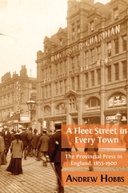Explore

At the heart of Victorian culture was the local weekly newspaper. More popular than books, more widely read than the London papers, the local press was a national phenomenon. This book redraws the Victorian cultural map, shifting our focus away from one centre, London, and towards the many centres of the provinces. It offers a new paradigm in which place, and a sense of place, are vital to the histories of the newspaper, reading and publishing.Hobbs offers new perspectives on the nineteenth century from an enormous yet neglected body of literature: the hundreds of local newspapers published and read across England. He reveals the people, processes and networks behind the publishing, maintaining a unique focus on readers and what they did with the local paper as individuals, families and communities. Case studies and an unusual mix of quantitative and qualitative evidence show that the vast majority of readers preferred the local paper, because it was about them and the places they loved. A Fleet Street in Every Town positions the local paper at the centre of debates on Victorian newspapers, periodicals, reading and publishing. It reorientates our view of the Victorian press away from metropolitan high culture and parliamentary politics, and towards the places where most people lived, loved and read. This is an essential book for anybody interested in nineteenth-century print culture, journalism and reading.At the heart of Victorian culture was the local weekly newspaper. More popular than books, more widely read than the London papers, the local press was a national phenomenon. This book redraws the Victorian cultural map, shifting our focus away from one centre, London, and towards the many centres of the provinces. It offers a new paradigm in which place, and a sense of place, are vital to the histories of the newspaper, reading and publishing.Hobbs offers new perspectives on the nineteenth century from an enormous yet neglected body of literature: the hundreds of local newspapers published and read across England. He reveals the people, processes and networks behind the publishing, maintaining a unique focus on readers and what they did with the local paper as individuals, families and communities. Case studies and an unusual mix of quantitative and qualitative evidence show that the vast majority of readers preferred the local paper, because it was about them and the places they loved. A Fleet Street in Every Town positions the local paper at the centre of debates on Victorian newspapers, periodicals, reading and publishing. It reorientates our view of the Victorian press away from metropolitan high culture and parliamentary politics, and towards the places where most people lived, loved and read. This is an essential book for anybody interested in nineteenth-century print culture, journalism and reading.At the heart of Victorian culture was the local weekly newspaper. More popular than books, more widely read than the London papers, the local press was a national phenomenon. This book redraws the Victorian cultural map, shifting our focus away from one centre, London, and towards the many centres of the provinces. It offers a new paradigm in which place, and a sense of place, are vital to the histories of the newspaper, reading and publishing.Hobbs offers new perspectives on the nineteenth century from an enormous yet neglected body of literature: the hundreds of local newspapers published and read across England. He reveals the people, processes and networks behind the publishing, maintaining a unique focus on readers and what they did with the local paper as individuals, families and communities. Case studies and an unusual mix of quantitative and qualitative evidence show that the vast majority of readers preferred the local paper, because it was about them and the places they loved. A Fleet Street in Every Town positions the local paper at the centre of debates on Victorian newspapers, periodicals, reading and publishing. It reorientates our view of the Victorian press away from metropolitan high culture and parliamentary politics, and towards the places where most people lived, loved and read. This is an essential book for anybody interested in nineteenth-century print culture, journalism and reading.
This book is included in DOAB.
Why read this book? Have your say.
You must be logged in to comment.
Rights Information
Are you the author or publisher of this work? If so, you can claim it as yours by registering as an Unglue.it rights holder.Downloads
This work has been downloaded 414 times via unglue.it ebook links.
- 151 - pdf (CC BY) at OAPEN Library.
- 263 - pdf (CC BY) at Unglue.it.
Keywords
- c 1800 to c 1900
- Economics, finance, business & management
- Industry & industrial studies
- Journalism
- local newspapers
- Media Studies
- Media, information & communication industries
- Modern period, c 1500 onwards
- Newspaper
- Press & journalism
- Print culture
- Society & culture: general
- Society & Social Sciences
- thema EDItEUR::3 Time period qualifiers::3M c 1500 onwards to present day::3MN 19th century, c 1800 to c 1899
- thema EDItEUR::J Society and Social Sciences::JB Society and culture: general::JBC Cultural and media studies::JBCT Media studies
- Time periods qualifiers
- Victorian culture
Links
DOI: 10.11647/OBP.0152Editions


